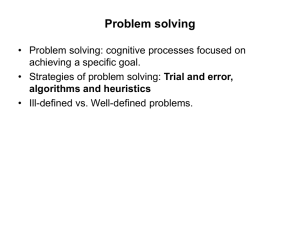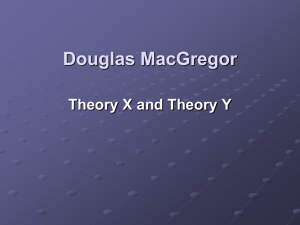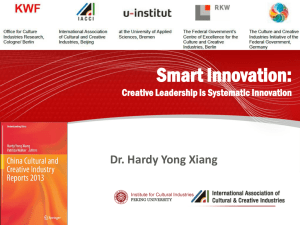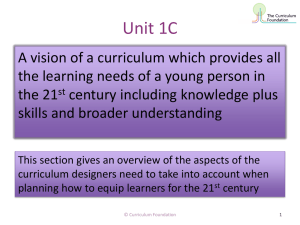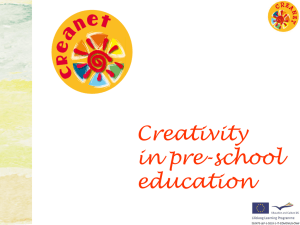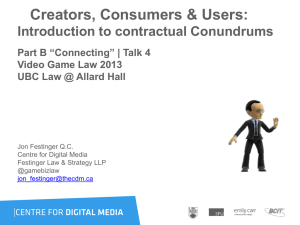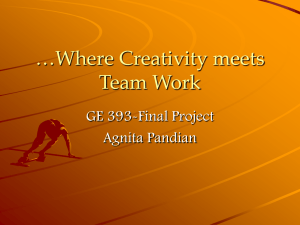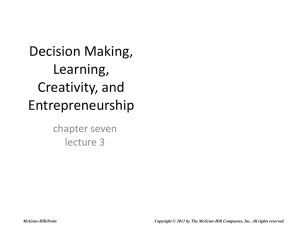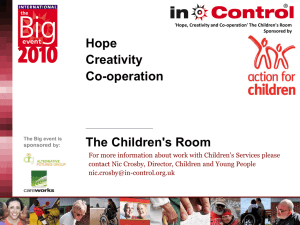Key Decisions - Oklahoma State University
advertisement
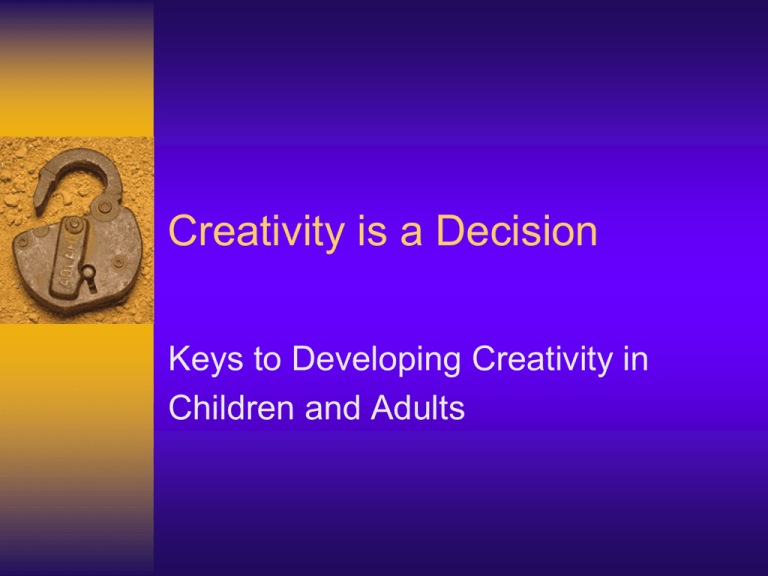
Creativity is a Decision Keys to Developing Creativity in Children and Adults Robert J. Sternberg Provost and Senior Vice President Oklahoma State University Collaborators – – – – – – – – – Todd Lubart Elena Grigorenko Linda Jarvin Linda O’Hara Wendy Williams James Kaufman Jean Pretz Janet Davidson Other Members of the PACE Center at Yale & Tufts Main Message Creativity is a decision! Goals To show that creativity is, in large part, a decision. To review the most recent research findings regarding creativity and its development. To show how to apply these ideas in educational settings. What is Creativity? Production of an idea or product that is – Novel – Good or useful in some way – Task appropriate Does Creativity Really Matter? The Costs of Lack of Creativity “The Big Three” vs Honda CDC (Control Data Corporation) vs IBM Eastern Airlines vs United Airlines When People Lack Creative Vision… "This 'telephone' has too many shortcomings to be seriously considered as a means of communication. The device is inherently of no value to us." -- Western Union internal memo, 1876. While theoretically and technically television may be feasible, commercially and financially it is an impossibility." -- Lee DeForest, inventor. When People Lack Creative Vision… We don't like their sound, and guitar music is on the way out." -- Decca Recording Co. rejecting the Beatles, 1962. "Stocks have reached what looks like a permanently high plateau." -- Irving Fisher, Professor of Economics, Yale University, 1929. Main Ideas Main Ideas Creativity is in large part a decision—to “defy the crowd.” Main Ideas Creative people seek to defy the crowd; by disposition, they create their own opposition Many reactions to famous ideas, when these ideas were first disseminated, were very negative Creativity can be developed Examples of Rotten Reviews This Side of Paradise (Fitzgerald, 1920): “It seems to us in short that this story does not culminate in anything.” The Diary of Anne Frank (Frank, 1952): “The girl doesn’t…have a special perception or feeling which would lift that book beyond the curiosity level.” Examples of Rotten Reviews Catch 22 (Heller, 1961): “I haven’t the foggiest idea about what the man is trying to say…This constitutes a continual and unmitigated bore.” Lady Chatterley’s Lover (Lawrence, 1928): “For your own good do not publish this book.” Examples of Rotten Reviews The Spy Who Came in from the Cold (LeCarre, 1963): “You’re welcome to LeCarre—he hasn’t got any future.” Atlas Shrugged (Rand, 1957): “I regret to say that the book is unsaleable and unpublishable.” Examples of Rotten Reviews The art of Edvard Munch, Roy Lichtenstein The science of Copernicus, Galileo Athletics: Ski-jumping Main Ideas Creative people “buy low” and “sell high” in the world of ideas. Creative people are “value” investors in the realm of ideas; very few people want to buy low and sell high, whether novices or experts – Forbes study Why it is Hard to be Creative External pressure Internal pressure Main Ideas There are 13 key or micro- decisions behind the macrodecision to be creative. Key Decisions To redefine problems – Example: Automobile executive Key Decisions To analyze creative solutions to problems – Example: The hapless student Key Decisions To sell solutions • Example: A talk at a testing company Key Decisions To realize that intelligence and knowledge both help and hurt creativity – Example: A trip to the zoo Key Decisions To take sensible risks – Example: Showdown at tenure time Key Decisions To overcome obstacles – Example: The ill-fated IQ test Key Decisions To find what one loves to do – Example: Playing the trumpet Key Decisions To continue to grow – Example: Talk when I was in graduate school Key Decisions To believe in oneself – Example: Dean Koontz Key Decisions To tolerate ambiguity – Example: Discovery of the structure of DNA Key Decisions To take oneself and one’s ideas somewhat lightly and to have a sense of humor – Example: The ill-fated colloquium in Pittsburgh Key Decisions To seek an environment that encourages and rewards creativity – Example: Transforming admissions Key Decisions To recognize that creativity is a way of life – Example: Pablo Picasso Teaching for Creative Thinking create design invent imagine suppose Teaching for Creative Thinking CREATE (a poem, sculpture, a new game) DESIGN (a new system of government for the classroom, a scientific investigation, a comfortable home INVENT (a new means of transportation, a new life form) Teaching for Creative Thinking IMAGINE (what life would be like in another country, what it would be like to be president of a country, how bees communicate with each other) SUPPOSE (worldwide temperatures keep increasing, people were paid to inform on neighbors who do not support the political party in power) Assessing for Creative Thinking Draw the Earth from an insect’s point of view How could you tell if there space aliens hiding among us ? Less Creative Response Test their knowledge of countries on the Earth to see if they know what the names of the major countries are More Creative Response Test their knowledge of television shows and movies that Earth children would have been likely to see when they were children What would the world be like today if some major event in history had come out differently? Creative Essay: “What if…” If the Trojans had heeded Laocoon’s advice and thrown Odysseus’ wooden horse into the sea, they would have defeated the Greeks at Troy. Aeneas would then never have had reason to flee the city, and he would never have ventured to Italy to found Rome. Without Rome, neither the Roman Republic nor a Roman Empire would have existed. Concrete, the arch, plumbing, and the sauna might never have been invented. The modern implications of Rome never having existed are indeed drastic. Lacking even concrete floors, people would resort to sleeping in the mud, and, without plumbing or saunas, they would be perpetually filthy and, generally, quite chilly. France could not have built the base of the Eiffel Tower without arches, so tourists would be unable to purchase miniature collectible Towers in Parisian convenience stores. Good but Less Creative Essay: “What if…” What if the ratification of the nineteenth amendment did not pass and women were never given the right to vote? What would life for women, like me, be like in the United States? For one thing, I probably would not be writing this essay. If women were not given their right to vote, I probably would stop going to school after this year and it would be unlikely that I would receive a college education. Without suffrage, my career options would be limited, if a career were a possibility at all. My accepted practices would be limited to staying home and taking care of the family. Rather than being equals, women would be subservient to men. I might not drive, I might not dress in the way in which I choose to, and I might not be able to live my life the way that I can in the twenty-first century. The Rainbow Project Measuring creativity (and practical thinking) via paper-and-pencil or computer can – Double prediction of first-year undergraduate grades – Reduce ethnic group differences by half The Kaleidoscope Project Measuring creativity on a university application can – Eliminate ethnic-group differences – Improve prediction of first-year grades – Select students who are more likely to be involved in meaningful extracurricular and leadership activities The Panorama Project A new project at Oklahoma State University to measure, in admissions, creative as well as other kinds of thinking (analytical, practical, wise) The Aurora Project Measuring creativity for 8-12 year olds across domains can enhance our identification of giftedness Suggested References Sternberg, R. J., & Grigorenko, E. L. (2007). Teaching for successful intelligence (2nd ed.). Thousand Oaks, CA: Corwin Press. Sternberg, R. J., Kaufman, J. C., & Grigorenko, E. L. (2008). Applied intelligence. New York: Cambridge University Press. Suggested References Sternberg, R. J., Jarvin, L., & Grigorenko, E. L. (2009). Teaching for wisdom, intelligence, creativity, and success. Thousand Oaks, CA: Corwin. Summing it Up “The End of Eternity” Conclusions Creativity is a decision Anyone can make this decision anytime So: Decide for creativity!
